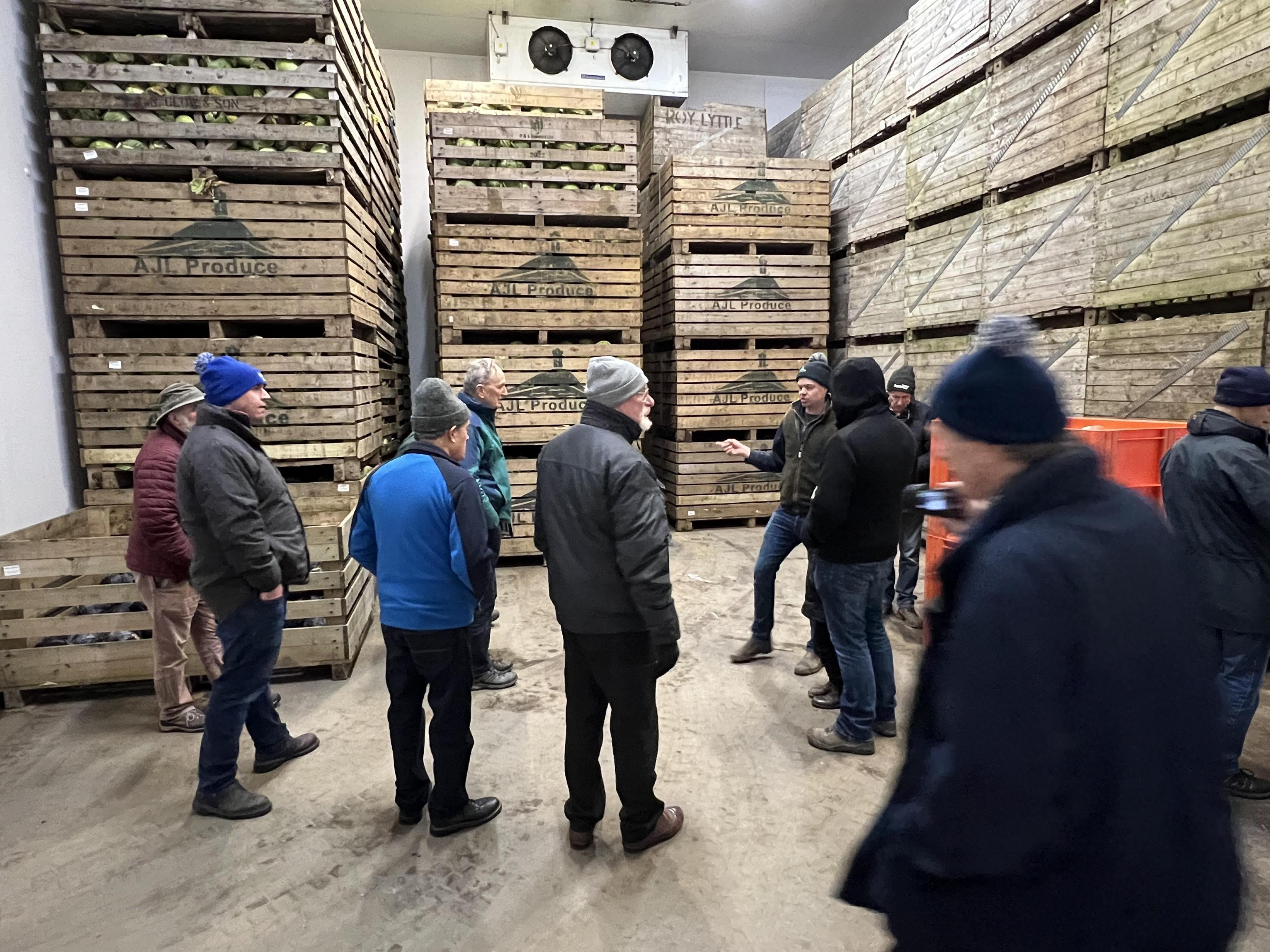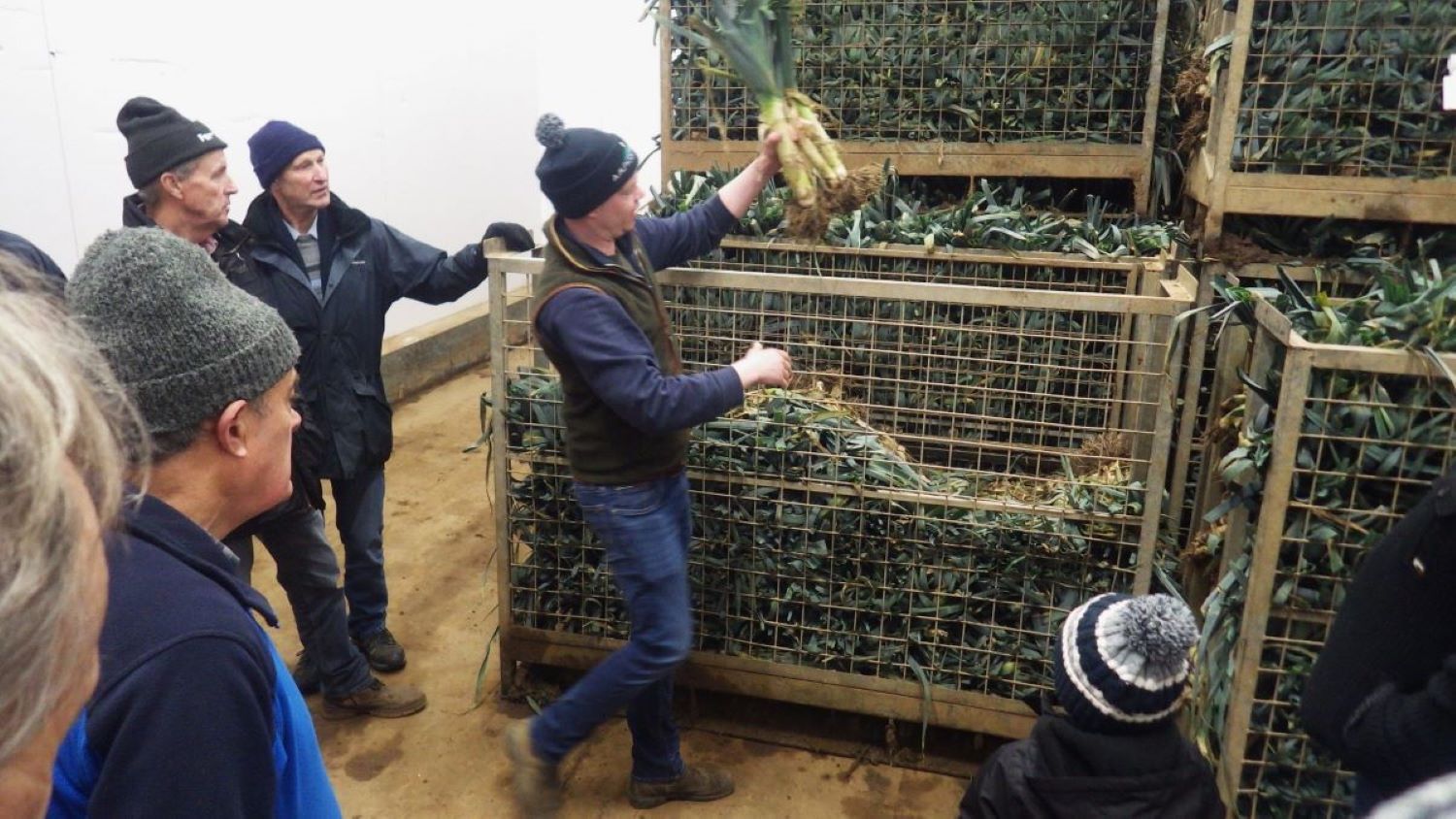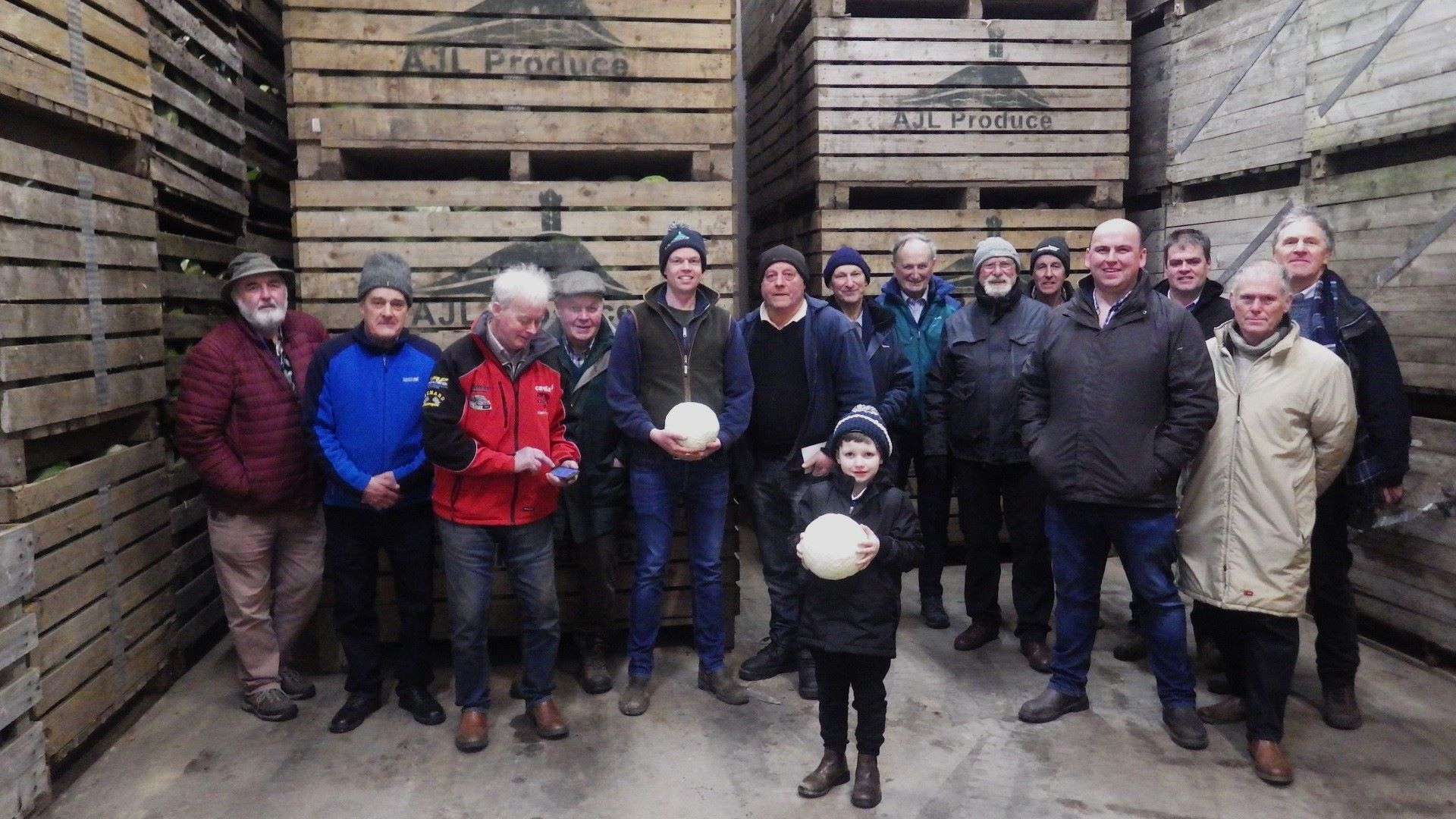

Visit to RL Produce
Northern Ireland IAgrE Branch members recently enjoyed a visit to RL Produce at Newtownards, Co.Down. This told the story of the business’s origins in 1980 and its continuous development to now being a main specialist supplier of fresh horticultural produce. Roy Lyttle left school in 1976 and started the business, with just 2 acres at his present HQ site, from 1980. His wife Sheila joined him, after their marriage in 1984, to be part of the business in addition to her teaching career. Their son, Alexander, joined the family business in 2015 following his 2 years of formal study at CAFRE Greenmount and more than a year of work experience in both New Zealand and Australia. He now manages the soil care and crop production part of the business.
The company initially sold their produce to retailers through the traditional Belfast fruit and vegetable market. In 1993 they began directly supplying the, then Stewarts Supermarket chain, and when it was acquired in 1997 by Tesco, they further developed direct farm contract sales with them. RL Produce became a limited company in 2004 and now also supplies Avondale Foods (Craigavon), Nature’s Best (Drogheda), Henderson Food (Newtownabbey), and a range of other wholesale and independent outlets.
The land
To get a wide choice of suitable land types a lot of it is rented, within a 10 mile radius, under the traditional Northern Ireland based conacre single- year rental system.
The total growing area now includes over 200 acres of conventional cropping and around 10 acres for organic crops.
The main crop regime includes Leeks, grown for 10 months of the year, and Spring Onions (also known as Scallions) for 6 months of the year.
The other crops include Beetroot, White Cabbage, Parsley, Soup Celery and Organic Potatoes.
Summer consumption of fresh veg is increasing within the developing consumer market. The direct demand for both unprocessed potatoes and turnips has eased back with the developments of locally processed mash products.
Cropping system
The husbandry systems seek to maximise the active growing seasons to ensure a steady supply for customers for most of the year. Leeks are precision seed sown at intervals from April onwards to provide crop for harvesting through to the following March. Earlier crops are from transplanted bare root plants flown in from Morocco. Fleece covers are also rolled out on some fields to raise soil temperature and expedite early growth. Localised rain gun irrigation may also be used at times to reduce the root stress in early transplants. The careful choice of suitable growing sites and the application of the above techniques has enabled crops to be harvested over a larger percentage (now 50 weeks) of the year.
Crop protection
Crop protection for control of weeds or fungal disease is a specialist skill and the choice of plant protection products, available to growers, has been decreasing. Detailed records of application times, rates and effectiveness are kept to comply with the various crop-assurance schemes and for year to year comparison of the effectiveness of the treatments. Minimisation of pesticide use is a priority based on the best timing and methods of application. One example is early seedbed preparation allowing surface grass weeds to germinate and be controlled by a herbicide before sowing takes place.
RL Produce has also recently acquired a new shrouded nozzle sprayer on which the individual protected spray nozzles are spaced to pass between the plant rows, near ground level, close to the weeds. Contact with the growing crop will be avoided and a wider selection of herbicides can be used. GPS satellite guidance provides accurate steering control of the tractor ensuring efficient field work with no overlaps. Other automatic on /off selective target applications to weed systems are being developed by the industry and, when commercially available, may become accepted practice to further reduce the amount and cost of pesticide application.
The accurate layout of all the fieldwork operations is now guided by electronic field maps and GPS guided steering systems on the tractors.
Cultivation systems
After ploughing, to bury surface weeds and incorporate organic plant material, the furrows are tilled to form a tilth on which the crop will be planted. Maincrop potato growers who plant into soils, like those in Co. Down, containing stones or clods now tend to use a separation process to separate out stones / clods and place them in narrow rows down between each pair of drills. This system is not so convenient for the narrow row layouts used for vegetable crops but the presence of excess stones / clods in the seedbed can still be undesirable.
RL Produce has recently acquired a Moate Tillerstar, wide powered tillage cultivator, which can separate and bury stones below the tilth across its entire working width in a one pass operation. Its bladed rotor rotates against the direction of travel throwing the soil upwards and back on to 4 full-width flexible star rollers. They rotate with the soil falling through but suspend the stones / clods to be carried forwards and drop into the temporary void created by the rotating rotor. The constant stream of soil falling through the separation system, as the tiller travels forward, forms the tilth layer on top of the stones. The tiller’s maximum working depth is around 35cm, but it can also cultivate more shallow seed beds such as 15cm for onion production.
Harvesting
Some manual harvesting may be required at times but most of the field crops are now collected by tractor driven semi-mounted single row mounted harvesters. The leek harvester travels along the rows gently pulling the individual plants, vibrating them to remove soil and deposit them in layers within a transport crate. The cabbage harvester also lifts from a single row to load into transport / storage boxes. Although the harvesters are reliable and efficient their performances are still monitored in the field by on-board personnel to immediately detect and rectify any sudden problems. To ensure maximum mobility and minimal soil compaction, over a range of weather and soil conditions, the 4 X 4 tractor used on the harvesters now travels on rubber tracks.
The production and packing areas
A specialist pack house was built in 1997 to process and pack the pre-washed crops which are held in temperature controlled facilities. Mechanical materials handling and automatic processing aids are included but the considerable skills and dedication of the manual workforce is much appreciated. Up to 35 people are employed at peak times with many regularly travelling seasonally, from Eastern Europe and beyond, to join the workforce in Newtownards. Some of the same people have been coming back regularly to work at RL Produce for more than 10 years.
The produce is pre-washed before being taken to the modern process lines where it is trimmed, weighed and packed for sending to the various customers. This ranges from whole product such as cabbages being sent out to coleslaw manufacturers for further processing to leek packs going for customers to purchase from the supermarket shelves.
RL Produce delivers its products, daily and directly, to its customers in its own chilled transport vehicles.
The packhouse was further extended in 2012. Further cool storage buildings followed including a specialist facility for cabbage preparation.
One example of precision equipment, as part of the production line, is the auto-scale weighing system for leeks. It can handle leeks up to 40 cm long. Above the minimum weight scale, target accuracy is influenced by how close the trimmed individual plants are to the selected pack size requirements. The aligned material enters a semi-automatic multi-head weigher before being directed to its pack wrapper. People who operate the system have become highly skilled in achieving the most efficient accuracy and outputs.
An example of personal practical innovation is Alex Lyttle’s own design of a system, using the discharge of compressed through a tapered cone for the rapid and effective removal of loose outer cabbage leaves.
Recycling and energy efficiency
In line with company policy of efficient and environmentally friendly production the roofs of the buildings carry Solar PV panels which currently can save up to £12,000 per year. All of the fresh, green plant by- product material removed during the preparation and packing processes is taken regularly to a local 500kW bio-digestion plant at which Alex Lyttle also has an active management role.
P R for local food production
In line with RL Produce’s policy of promoting public understanding and appreciation of how their crops are produced and prepared the packhouse includes an enclosed elevated viewing gallery from which supervised groups, including children, can safely observe the detail of what goes on. Sheila described how around 30 groups, from local schools, Young Farmers Clubs and others visit in this way each year. The food industry has stated its appreciation of this good work in the form of public awards.
RL Produce’s distinctive logo reflects their impressive location on the edge of Strangford Lough across which the distinctive Scrabo Tower is clearly visible.
After a very enjoyable and informative guided tour, of the storage and processing facilities, we thanked both Sheila and Alex for their warm hospitality and for sharing with us the details of their company’s formation, expansion and everyday working activities. We also got to enjoy some of Sheila’s delicious Leek and Potato Soup before leaving this memorable and enjoyable visit with some actual fresh leeks and a recipe to help us make more of it at home ! More details of the company’s activities, products and awards can be viewed on
www. nigoodfood.com/producers/roy-lyttle-limited/




career - your passport to professionalism...
If you have a query about events, click here...



